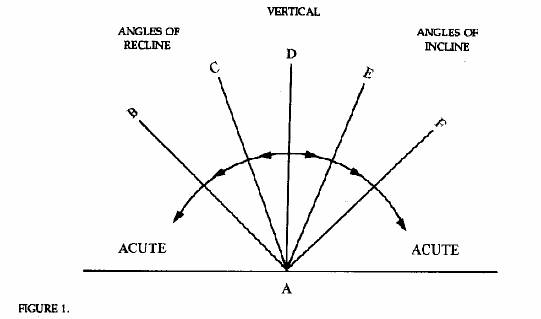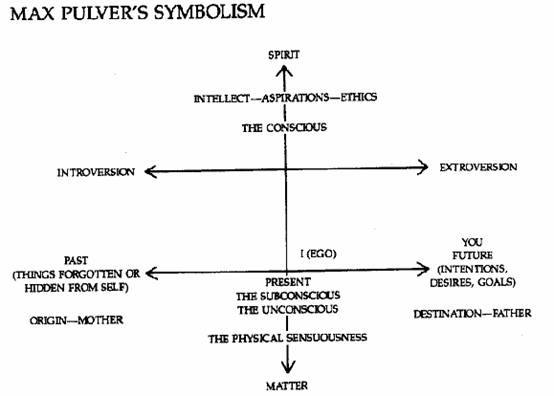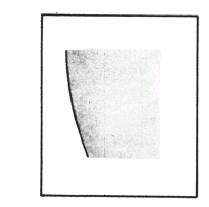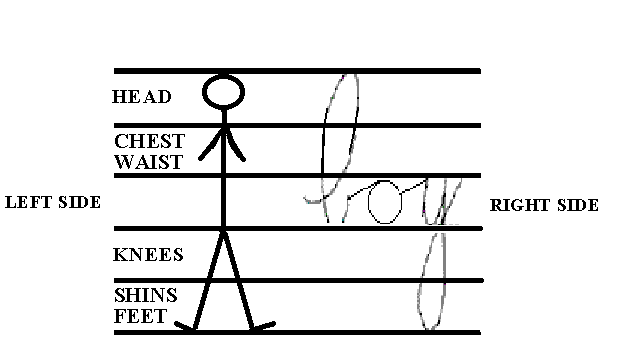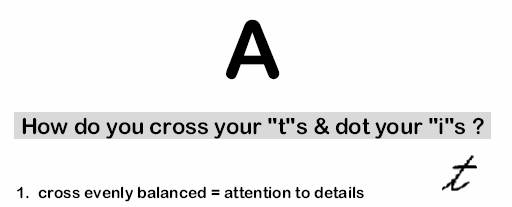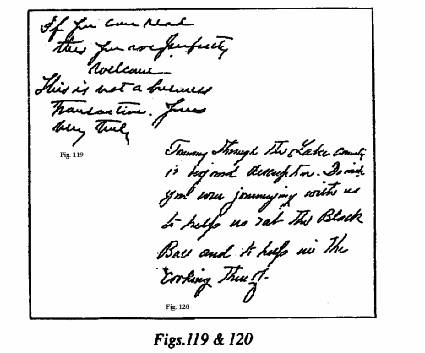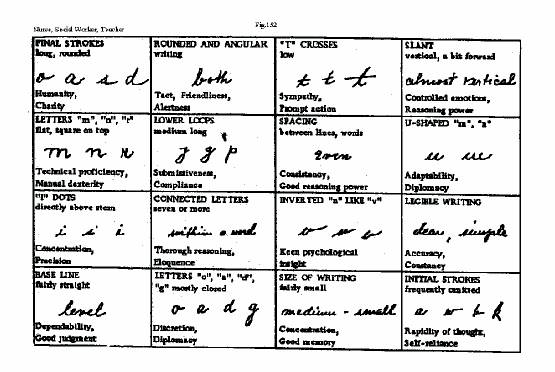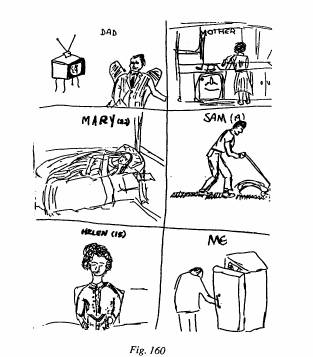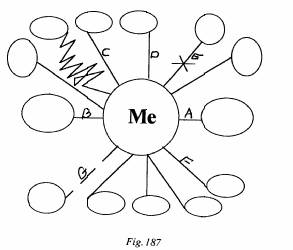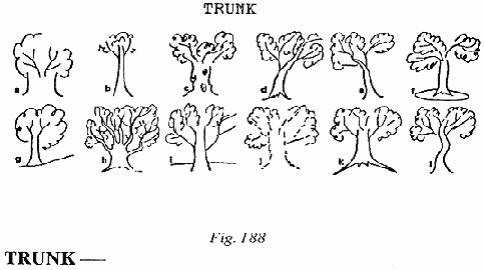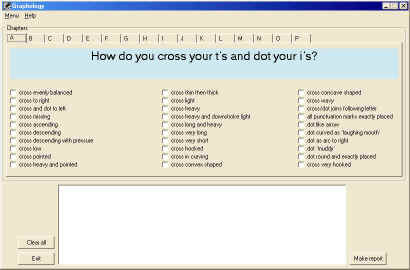
|
Home Page About Rabbi Yoseph Engel The Program Contact Us |
THE PROGRAM - Handwriting Analysis at Home
Lesson 1. What Is Graphology?Graphology is the study of handwriting and what it can tell about the mind behind it. When a person writes, it's his hand that does the writing, but his brain that does the dictating. There have been many cases of amputees who, having lost the hand or arm with which they wrote, relearned the art with either the other hand, or the feet, or the mouth. Aside from a certain understandable shakiness caused by the difficulties of the feat, the writings were extremely similar to the originals. Trained graphologists had no trouble recognizing the same individual. From this, we see that it is the personality that is expressed on paper by the handwriting…
Lesson 2. The Slant 6
Picture a man standing bolt upright--the very image of independence, separateness. In Figure 1, look at line AD-it is straight. When one writes in such a fashion more or less consistently, we say that his writing is vertical. In line AE, however, we have a picture of a man reaching out to speak with someone, as though he were trying to meet the other person part way…
Lesson 3. The Zones 12
If we were to superimpose a written word with a t in it on the spot marked I (Ego) Present, and the t coincided with the straight up-and-down line, we would be talking about a vertical writer. If the t veered to the right, we see from the chart that it would point toward the future. Were it to veer to the left, it would point toward the past. But this same word-say, the word “height”-also reaches into an upper and lower dimension. Upper, middle, and lower areas are called dimension zones, and they make up the zonal area. Think of a child's drawing-a boy standing on a piece of land, the sun shining and some clouds above. Zones are something like that picture. The upper zone represents sky, clouds, the sun-by extension what is high, spiritual, religious, lofty. Conversely, the lower zone represents earth, solidness, what is underfoot-things that are basic, common, earthy, materialistic, sexual. The middle zone is the person, the ego, the me. When handwriting is predominantly in one zone, we see a powerful key to personality. Handwriting confined to the middle zone demonstrates the social person, the today person, the one concerned with Number One and lacking spiritual as well as physical drive.
Lesson 4. The t bar 29 To the graphologist, the two most important letters for analysis are the small t and the letter i.
The postplaced t bar in Figure 2 is flying away from the stem. Often such writers have quick minds. Their purpose is not exactness in detail; they want to finish quickly. They are aggressive, often showing temper, impatient to reach their goals.
Lesson 5. The i dot 46
The i dot in Figure 8 is exactly above the stem. This is the sign of accuracy, perfection, excellent judgment, excellent memory, strong adherence to details. This writer often has a matter-of-fact personality. He is not only careful in dotting the i, but places it exactly where it belongs. This shows concentration. Many judges and scientists dot their i's in this fashion. The i dots which are exactly above the i stem are often found among people who are considered highly moral people…
Lesson 6. Sexuality 59 Sexuality, of course, plays an important role in our lives. The zone that represents it is the lower zone, and the letter that reveals its quality most effectively is the letter g.
Lesson 7. The Base Line 72 In handwriting analysis, the base line-how straight the subject writes-reflects mood. In order to ensure that the base line is accurately read it is best that the paper be unlined, for lined paper has a way of guiding the writer in a course, which may not be his real self.
As the base line begins ascending, we see the degree of optimism: the higher the ascent the higher the degree of optimism -along with a higher degree of impracticality.
Lesson 8. Margins 79 The margin shows how the writer spends his money and his attitude toward handling friends.
At the end of the first line the writer stops where it seems to him most appropriate and returns to the left margin to start a second line. Some writers will deliberately choose, point by point and line-by-line, a straight lef t margin, others are carried away by their enthusiasm, their impatience, or whatever emotion accompanies the writing; they move the starting point of the written lines more and more to the right, toward the right margin-the left margin widens.
Lesson 9. Beginning and End Strokes 86 When someone starts to write a letter, he must immediately decide where and how he should form it. Likewise when one finishes a word. The end stroke represents a man’s true personality, whereas the beginning stroke represents what he sees in himself and what he wants others to see in him. The end stroke shows the reality of how he relates to his fellowman. The beginning letter demonstrates his self-image, while the end stroke demonstrates his true feelings about the one he is writing to. In general, a man starts off trying to give the best possible impression of himself, and this shows in the beginning stroke. After a while, he lets his guard down, and at the end he is not so conscious as he was of giving that good first impression. He has asserted himself; he no longer needs to be so conscious of his appearance. Therefore we see his true character emerge. It is always interesting to compare the beginning strokes with the end ones, a comparison that yields a wealth of information.
Lesson 10. Connected and Disconnected Writing 97 Figure 1
Figure 1 shows an example of connected writing. One of the major points that the graphologist looks for in his analysis is how the subject thinks. In this example, we see that each word is internally connected, each letter linked to the following one. Connected writing shows a person who is both practical and logical. He will take his time figuring something out, but once he has done so, he is very tenacious of his opinion. He is the person who builds fact upon fact, then adds them up to a logical decision.
Lesson 11. Forms of Connection 105 When the expression form of connection is used, it means how the upstrokes and the downstrokes are connected-usually somewhere in the middle zone. Should the connections occur in another zone, particular emphasis is being shown by the writer in all that this particular zone represents. Since the connecting strokes by nature meet in the middle zone and the middle zone is indicative of the writer’s social relationships, it gives the graphologist strong insight into the writer’s social life.
Lesson 12. Pressure 122 One of the most important ways of finding out whether a person is extroverted introverted, or ambiverted is by looking at his writing pressure. Pressure is a sign of how forceful the individual is. FIGURE 2.
Figure 2 shows heavy pressure. This writer’s major drives are physical (try writing this hand and see how much strength it requires). He is materialistic, forceful, and rarely modest. At work, if perseverance is necessary, he is the man for the job, for he rarely gives up. He has natural energy and is determined to succeed. He enjoys being among people, is an extrovert, and prefers a “fast” crowd.
Lesson 13. Loops 134
FIGURE 1.
Figure 1 shows neither an upper loop nor a lower one, only single strokes. If there had been loops, they would not have made the letters more readable. This writer reduces everything to its simplest form. Any stroke that is not essential is omitted. As long as the word is readable, why add loops? In whatever this writer does, his method is direct.
Lesson 14. The Letters 138
The arc in Figure 15 points back to the capital letter (the ego) and therefore shows egotism.
Lesson 15. The Signature 182
Though the woman in Figure 14 did sign her name with the title “Mrs.,” it and her husband's last name are small in comparison to her own given name. She is prouder of herself than of her husband.
Lesson 16. Health 189 Handwriting analysis can often be useful in detecting malfunctions in the body.
If the handwriting in Figure 1 were superimposed on the stick figure in the above diagram, we would see that the top part of the upper-zone letters would correspond to the head. There are tremulous strokes and even a little gap in one of the letters-all in the same area, the left side of the top of the upper-zone letter. We can easily see why this writer should complain of headaches.
Lesson 17. How to Do an Analysis 200Consider the list of traits that the graphologist analyzes (see introduction). It would definitely be helpful to the beginning analyst to use this list until it becomes natural to him, so he no longer needs it and can do the analysis without having to refer to it-although the trained graphologist uses this list automatically.
Lesson 18. The Writing on the Envelope 207 One of the major aspects of envelope writing is consideration. The writer wishes his letter to arrive in the hands of the addressee. When we see a neat, legibly addressed envelope, we see consideration for the mailmen and all the other people who have to handle the letter en route to the intended address.
Lesson 19. Graphology in a Nutshell 212
Section 2 279
Lesson 20. Doodles 280 Notice figure 16, squares or other geometric designs signify a practical nature.
Lesson 21. Draw a Person 286How one draws a person reveals a great deal. Maternal figure regarded as rejecting , unloving, unsupportive: hands omitted on female figure.
Lesson 22. Matchmaking through Handwriting Analysis 307
By glancing at figures 119 and 120 you will find the script of two individuals, who are as perfect a complement of each other as could be found. The holograph of each slants perceptively to the right, indicating deep abiding love and the tendency to idolize each other. In figure 119, the man has a strong will and determination, shown by the even pressure and the crossings, this combined with the slant gives steadfastness and tenderness.
Lesson 23. Vocational Guidance 313Do you know if you are doing the work for which you are really suited? With what talents teenage children are gifted, which might be developed through the right course of education? Which is the right person for that special position in your organization? This aptitude guide will enable you to answer all of these questions. Find in the index that follows the type of work in which you are interested, then place the handwriting beside the page. If many of the signs in the aptitude guide are present in the handwriting, you can be certain that the writer is qualified for that type of work. Nurse, Social Worker, Teacher
Lesson 24. Kinetic Family Drawings 327
Notice figure 160. Mike was a seventeen year old boy brought to the hospital because of withdrawal symptoms. His father had a history of a car accident with a head injury and being extremely irritable subsequent to this. Mike felt completely isolated and rejected by the father. Note in the drawing the compartmentalization. This is a method that children use to isolate themselves from people and to deny feelings. Note the distance between Mike and the father in the drawing and his turning to the refrigerator for nurture rather than to people…
Lesson 25. Relationship with Family 349Potentially every person has seven close relatives. A father, mother, brothers, sisters, sons, daughters and a spouse. In figure 187, stemming from the encircled me, lines are drawn ending in balloons. Write the name of each of these relatives in the balloon that is most appropriate, call them what you usually would, and write nearby their relationship to you. If you so desire, you can add other relatives, friends and acquaintances.
Lesson 26. Trees 351
Broad- Exaggerated self-confidence…
This accurate and user friendly program is given as part of the course:
|
